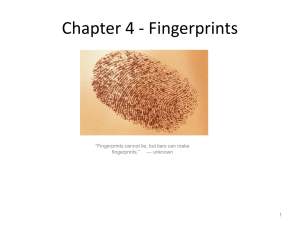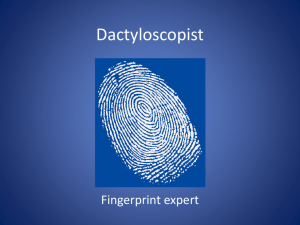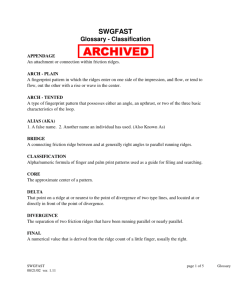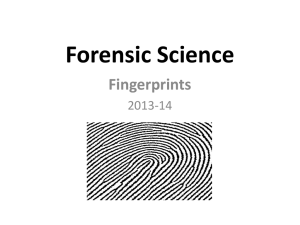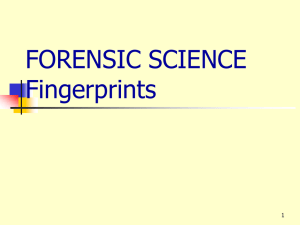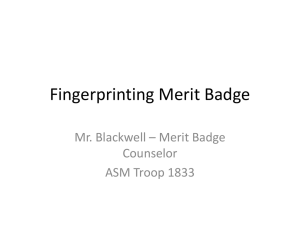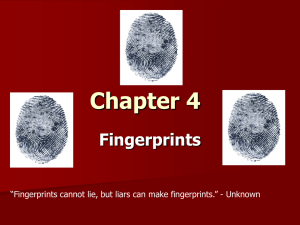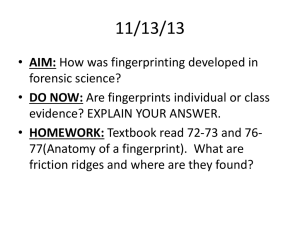File - Mrs. Hille`s FunZone
advertisement
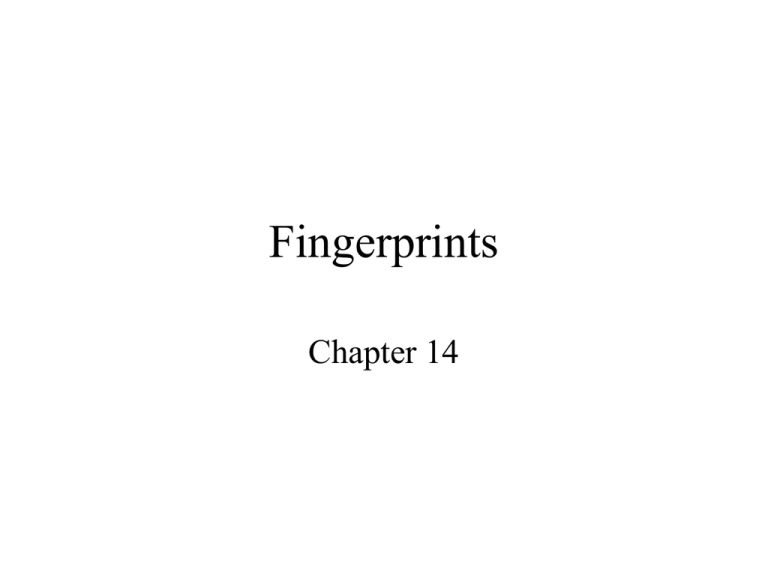
Fingerprints Chapter 14 History • Alphonse Bertillon - first systematic attempt at personal indentification – detailed description of subject (portrait parle´) • a verbal description of a perpetrator’s physical characteristics and dress provided by an eyewitness – full-length and profile photographs – system of 11 precise body measurements (anthropometry) • this rested on the premise that every body had unique dimensions which remained constant from age 20 until death History • Henry Fauld - first to publish views on the potential application of fingerprinting to personal identification • Francis Galton - published the first book “Finger Prints” on the subject; also devised the three types - loops, arches, and whorls – the book convincingly demonstrated that no two prints were identical and that prints remained the same from year to year History • Dr. Juan Vuetch - 1891 - devised a workable classification system that allowed prints to be filed and retrieved; still widely used in Spanish-speaking countries. • Sir Edward Richard Henry - 1897 proposed another classification system that was adopted by Scotland Yard in 1901 and is used in most English-speaking countries in some capacity today. History • New York City Civil Service Commission - 1901 first to use fingerprints for personal identification purposes in the United States • 1924 - the fingerprint records of the Bureau of Investigation and Leavenworth were merged to form the new FBI data base. • 1999 - the admissibility of fingerprint evidence was challenged. Judge upheld the admissibility of fingerprints as scientific evidence and ruled that (1) human friction ridges are unique and permanent and (2) human friction ridge skin arrangements are unique and permanent. Fundamental Principles of Fingerprints First Principle A fingerprint is an individual characteristic; no two fingers have yet been found to possess identical ridge characteristics First Principle • Galton - showed through mathematical calculations that theoretically there existed a possibility of 64 billion different fingerprints • Also proven by the fact that there have been millions and millions of prints taken in the last 90 years and there have never been two the same First Principle • The individuality of a fingerprint is not determined by its general shape or pattern; this would classify in the class characteristic • Ridge characteristics (aka minutiae) - ridge endings, bifurcations, enclosures, islands, ridge crossings, short ridges, etc. • The identity, number, and relative location of characteristics will impart individuality to a fingerprint Second Principle A fingerprint will remain unchanged during an individual’s lifetime Second Principle • Fingerprints are a reproduction of friction skin ridges found on the palm side of the fingers, thumbs, palms, and soles of the feet. • These ridges are designed to provide a firmer grasp and a resistance to slippage. Anatomy of Skin • Layers: – Epidermis outer layer – dermis - inner layer – dermal papillae - boundary between the epidermis and dermis • shape of boundary determines the form and pattern of ridges on the surface of the skin that causes the fingerprint – sweat gland - a pore in each skin ridge that allows for perspiration to be discharged and deposited on the surface of the skin Anatomy of Skin • To alter the fingerprint one would have to change the dermal papillae layer. A cut of 1-2 mm below the skin surface could penetrate the dermal papillae layer however the scar would then become a characteristic • It is totally impossible to completely obliterate the entire ridge pattern from a person Third Principle Fingerprints have general ridge patterns that permit them to be systematically classified. Third Principle • Whorls - 30-35% of the population – a class of fingerprints that includes ridge patterns that are generally rounded or circular in shape and have two deltas • Loops - 60-65% of the population – a class of fingerprints characterized by ridge lines that enter from one side of the pattern and curve around to exit from the same side of the pattern • Arches - ~5% of the population – a class of fingerprints characterized by ridge lines that enter the print from one side and flow out the other side Whorls • Whorls - must have at least two deltas and type lines – Plain whorl - if an imaginary line drawn between the two deltas touches any one of the spiral ridges; has at least one ridge that makes a complete circuit – Central pocket loop - if an imaginary line drawn between the two deltas does not touch any one of the spiral ridges; has at least one ridge that makes a complete circuit – Double Loop - made up of two loops combined into one fingerprint – Accidental - contains two or more patterns (not including the plain arch) or is a pattern not covered by other categories Plain Whorl http://www.nist.gov/srd/fing_img.htm Loops • Loop - must have one or more ridges entering from one side of the print, recurving, and exiting from the same side; must have one delta – type lines - the pattern area of the loop is surrounded by two diverging ridges known as type lines – delta - the ridge point at or nearest the type-line divergence and located at or directly in front of the point of divergence – core - the approximate center of the pattern – Radial loop - opens toward the thumb – Ulnar loop - opens toward the little finger Right Loop http://www.nist.gov/srd/fing_img.htm Left Loop Arches • Arches - do not contain type lines, deltas, or cores – Plain arch - simplest of all fingerprint patterns; formed by ridges entering from one side of the print and exiting on the opposite side; ridges tend to rise in the center of the pattern forming a wavelike appearance – Tented arch - similar to the plain arch except the rise is a sharp upthrust or spike instead of a smooth rise Plain Arch http://www.nist.gov/srd/fing_img.htm Tented Arch Classification of Fingerprints • Primary Classification - part of the original Henry system and is the first step – provides that all fingerprints can be initially classified into 1024 groups – all fingers are paired up into fractions in this specific sequence R-Index R-Ring L-Thumb L-.Middle L-Little R-Thumb R-Middle R-Little L-Index L-Ring Classification of Fingerprints • The whorl pattern is the basis for the determination • If a whorl is present a number is assigned – – – – – pair 1 = 16 pair 2 = 8 pair 3 = 4 pair 4 = 2 pair 5 = 1 • The total for the numerator and denominator is summed and 1 is added to both. • Approximately 25% of the population have 1/1 primary classification. This is a class characteristic! AFIS • Automated Fingerprint Identification Systems – uses automatic scanning devices that convert the image of a fingerprint into digital minutiae that contain data showing ridges at their points of termination (ridge endings) and the branching of ridges into two ridges (bifurcations). • Automation allows for less time identifying a suspect and more time to investigate the suspect the computer generated. Methods of Detecting Fingerprints • Types of fingerprints: – latent - aka invisible - impressions caused by the transfer of body perspiration or oils present on the finger ridges to the surface of an object – visible - made by fingers touching a surface after the ridges have been in contact with a colored material such as blood, paint, grease, or ink – plastic - ridge impressions left on a soft material such as putty, wax, soap, or dust Methods of Detecting Fingerprints • How to visualize the latent prints – Hard and nonabsorbent surfaces - preferably developed by application of a powder or treatment with Super Glue • glass, mirror, tile, and painted wood – Soft and porous surfaces - treated with one or more chemicals • papers, cardboard, and cloth Powders • Generally gray and black sufficient for most – examiner chooses powder that best contrasts the color of the surface. • Gray - aluminum metal - applied to dark colors and mirrors or metal surfaces…because when it is photographed the surface will be black • Black - charcoal - applied to light colored surfaces Chemical Methods • Iodine fuming - sublimes during heating; not permanent; fades very quickly; can be held for a few weeks if sprayed with a starch solution - print will turn blue – thought that the fumes combine with fatty oils and/or the residual water left on a print from perspiration Chemical Methods • Ninhydrin - reacts with amino acids present in the perspiration; forms a purple-blue print – sprayed onto the porous surface – prints develop within an hour or two; weaker prints may take 24-48 hours; heating the treated specimen speeds up the visualization Chemical Methods • Physical Developer - silver nitrate-based liquid reagent; final chemical resort – shown to be very effective on porous articles that may have been wet at one time • Specific order for visualizing prints 1) - iodide fuming 2) - ninhydrin 3) - Physical Developer Chemical Methods • Super Glue fuming - done on nonporous surfaces – metals, electrical tape, leather, plastic bags, – cyanoacrylate ester - reacts with and visualizes a latent print Fluorescent Techniques • Laser light illuminates the components in perspiration that naturally fluoresce. • Fluorescence is the phenomenon that occurs when a substance absorbs light and reemits the light in wavelengths longer than the illuminating source. • Substances that emit light or fluoresce are more readily seen with the naked eye or through photography as compared to non-light-emitting materials. • The high sensitivity of fluorescence serves as the underlying principle of many of the new chemical techniques used to visualize latent prints. Fluorescence Advancements • Chemicals that would induce fluorescence when exposed to laser illumination. – Ie. Applying zinc chloride after ninhydrin – ie. Applying rhodamine 6G after super glue • Alternate Light Source systems - high intensity light sources have replaced most lasers; must less expensive; portable – ie. Quartz halogen, xenon arc, indium arc Miscellaneous Information • Chemical treatments of fingerprints do not interfere with DNA testing. • Latent Print Preservation – an initial photograph must be taken – if item can be removed and preserved as evidence this is done properly – if item is too large or permanently attached then the print is “lifted” with tape and placed on a card for preservation. Miscellaneous Information • Digital imaging - the process by which a picture is converted into a digital file; the image produced from this digital file is composed of numerous square electronic dots called pixels – grayscale - only contains black (0) and white (255); can manipulate the color by changing the value – resolution - reveals the degree of detail; 600x800 pixels; the larger the numbers the closer the image resembles the real image • Frequency analysis - frequency Fourier transform (FFT) is used to identify periodic or repetitive patterns such as lines or dots that are interfering with the interpretation of the image; these can be diminished or eliminated to enhance the image

